Fintech's Impact on Financial Inclusion in Pakistan: A Report
VerifiedAdded on 2022/08/29
|11
|2306
|37
Report
AI Summary
This report provides an overview of the Fintech landscape in Pakistan, focusing on its role in promoting financial inclusion. It examines the Fintech revolution, highlighting the increasing use of digital payments, mobile wallets, and branchless banking. The report discusses the importance of financial inclusion, the current status in Pakistan, and the key players such as Telenor, Karandaaz, and Alibaba's Ant Financial. It analyzes the impact of Fintech on the economy, including potential contributions to GDP, job creation, and government reserves. The report concludes that Pakistan is an emerging market for Fintech, offering unique opportunities to increase financial inclusion through digital technologies, and emphasizes the significant role of various organizations in promoting Fintech in the country.
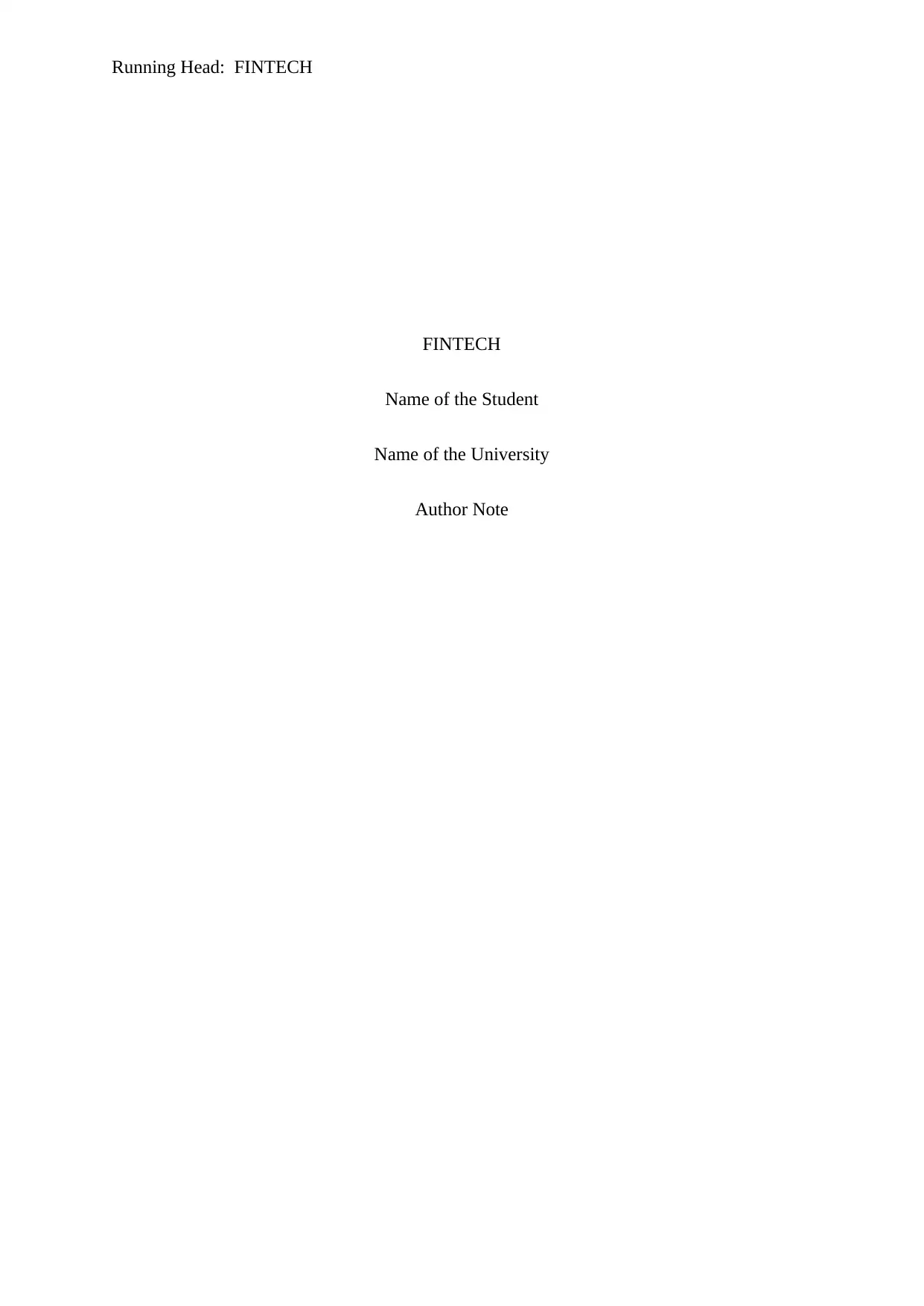
Running Head: FINTECH
FINTECH
Name of the Student
Name of the University
Author Note
FINTECH
Name of the Student
Name of the University
Author Note
Paraphrase This Document
Need a fresh take? Get an instant paraphrase of this document with our AI Paraphraser
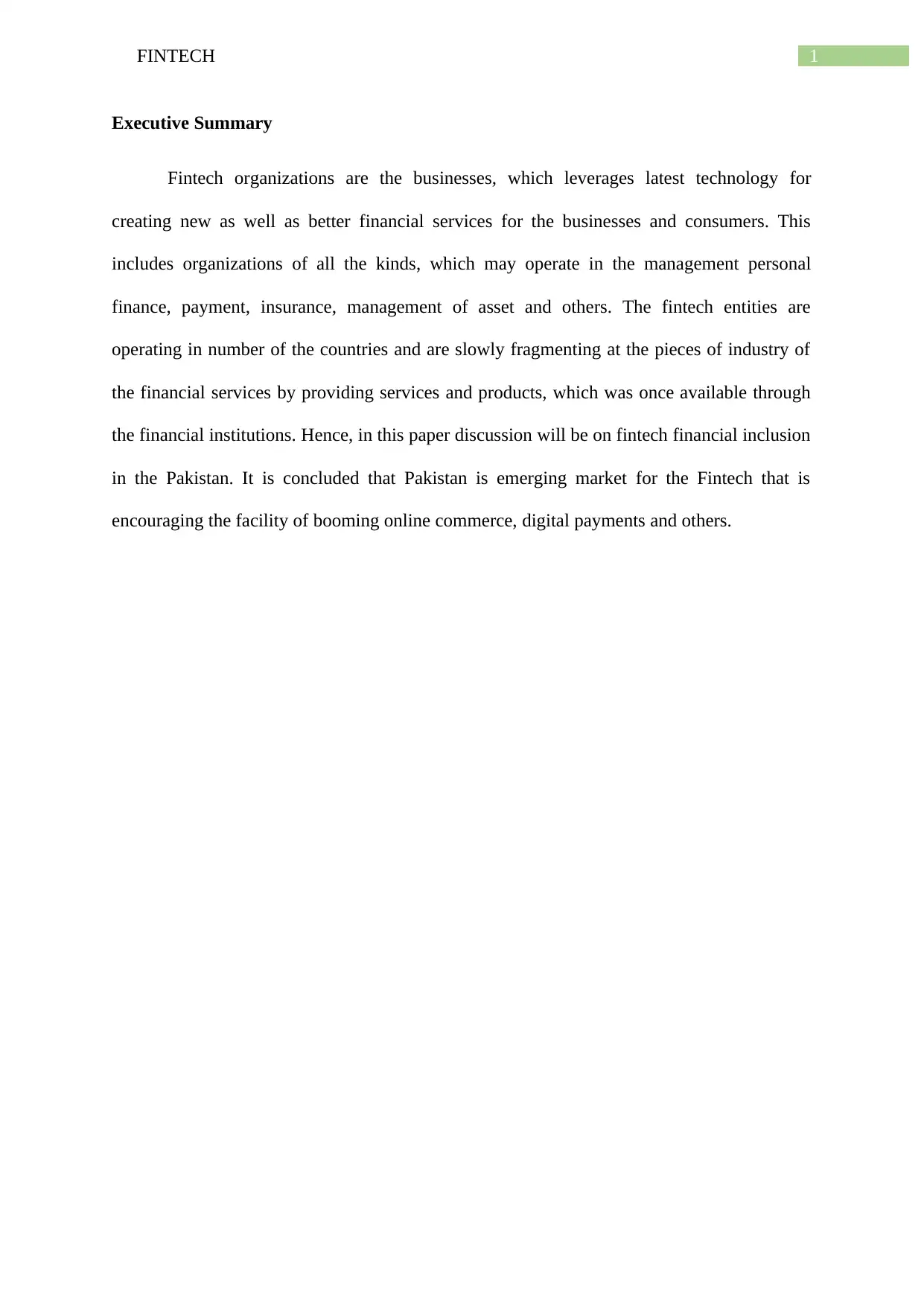
1FINTECH
Executive Summary
Fintech organizations are the businesses, which leverages latest technology for
creating new as well as better financial services for the businesses and consumers. This
includes organizations of all the kinds, which may operate in the management personal
finance, payment, insurance, management of asset and others. The fintech entities are
operating in number of the countries and are slowly fragmenting at the pieces of industry of
the financial services by providing services and products, which was once available through
the financial institutions. Hence, in this paper discussion will be on fintech financial inclusion
in the Pakistan. It is concluded that Pakistan is emerging market for the Fintech that is
encouraging the facility of booming online commerce, digital payments and others.
Executive Summary
Fintech organizations are the businesses, which leverages latest technology for
creating new as well as better financial services for the businesses and consumers. This
includes organizations of all the kinds, which may operate in the management personal
finance, payment, insurance, management of asset and others. The fintech entities are
operating in number of the countries and are slowly fragmenting at the pieces of industry of
the financial services by providing services and products, which was once available through
the financial institutions. Hence, in this paper discussion will be on fintech financial inclusion
in the Pakistan. It is concluded that Pakistan is emerging market for the Fintech that is
encouraging the facility of booming online commerce, digital payments and others.
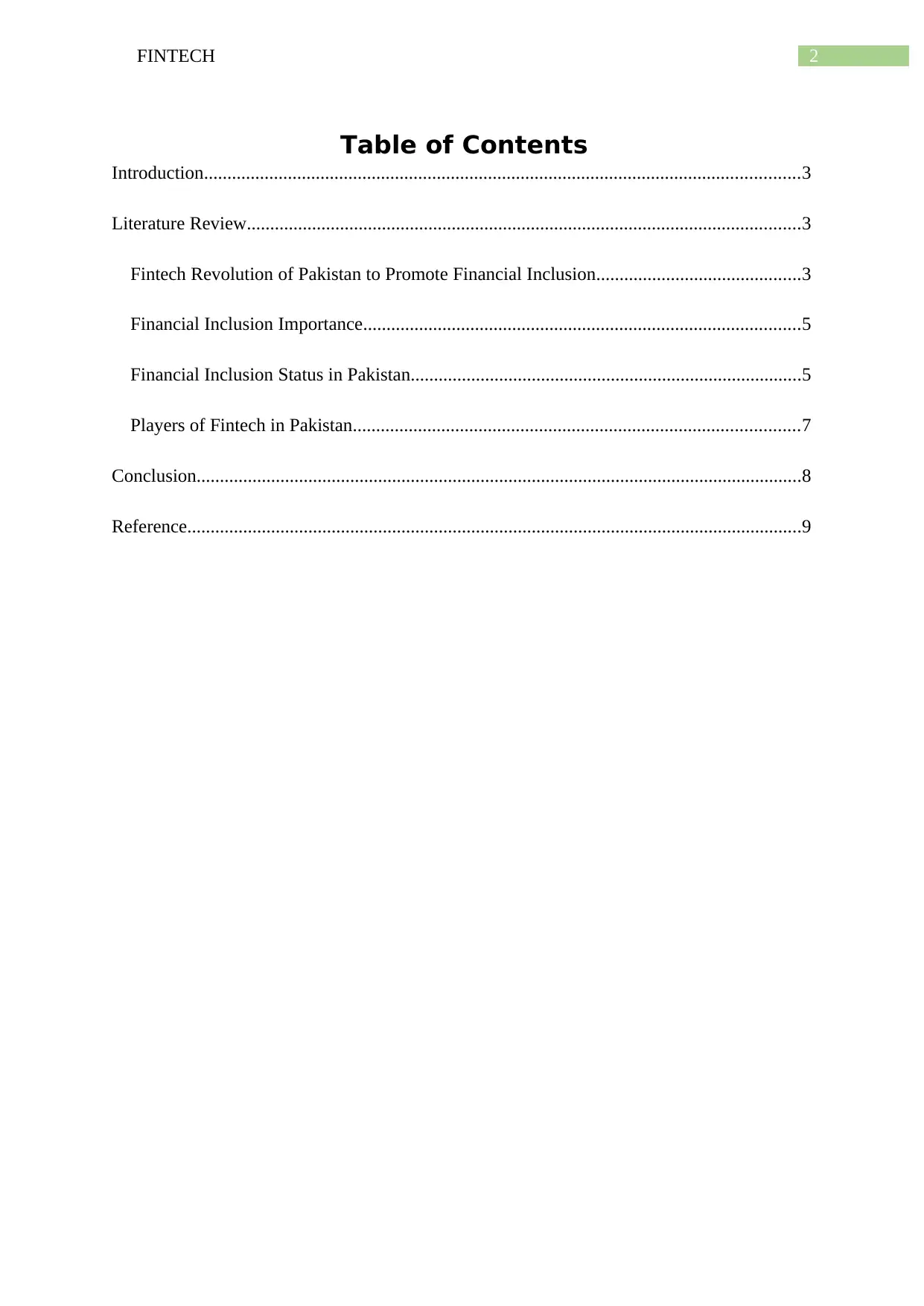
2FINTECH
Table of Contents
Introduction................................................................................................................................3
Literature Review.......................................................................................................................3
Fintech Revolution of Pakistan to Promote Financial Inclusion............................................3
Financial Inclusion Importance..............................................................................................5
Financial Inclusion Status in Pakistan....................................................................................5
Players of Fintech in Pakistan................................................................................................7
Conclusion..................................................................................................................................8
Reference....................................................................................................................................9
Table of Contents
Introduction................................................................................................................................3
Literature Review.......................................................................................................................3
Fintech Revolution of Pakistan to Promote Financial Inclusion............................................3
Financial Inclusion Importance..............................................................................................5
Financial Inclusion Status in Pakistan....................................................................................5
Players of Fintech in Pakistan................................................................................................7
Conclusion..................................................................................................................................8
Reference....................................................................................................................................9
⊘ This is a preview!⊘
Do you want full access?
Subscribe today to unlock all pages.

Trusted by 1+ million students worldwide
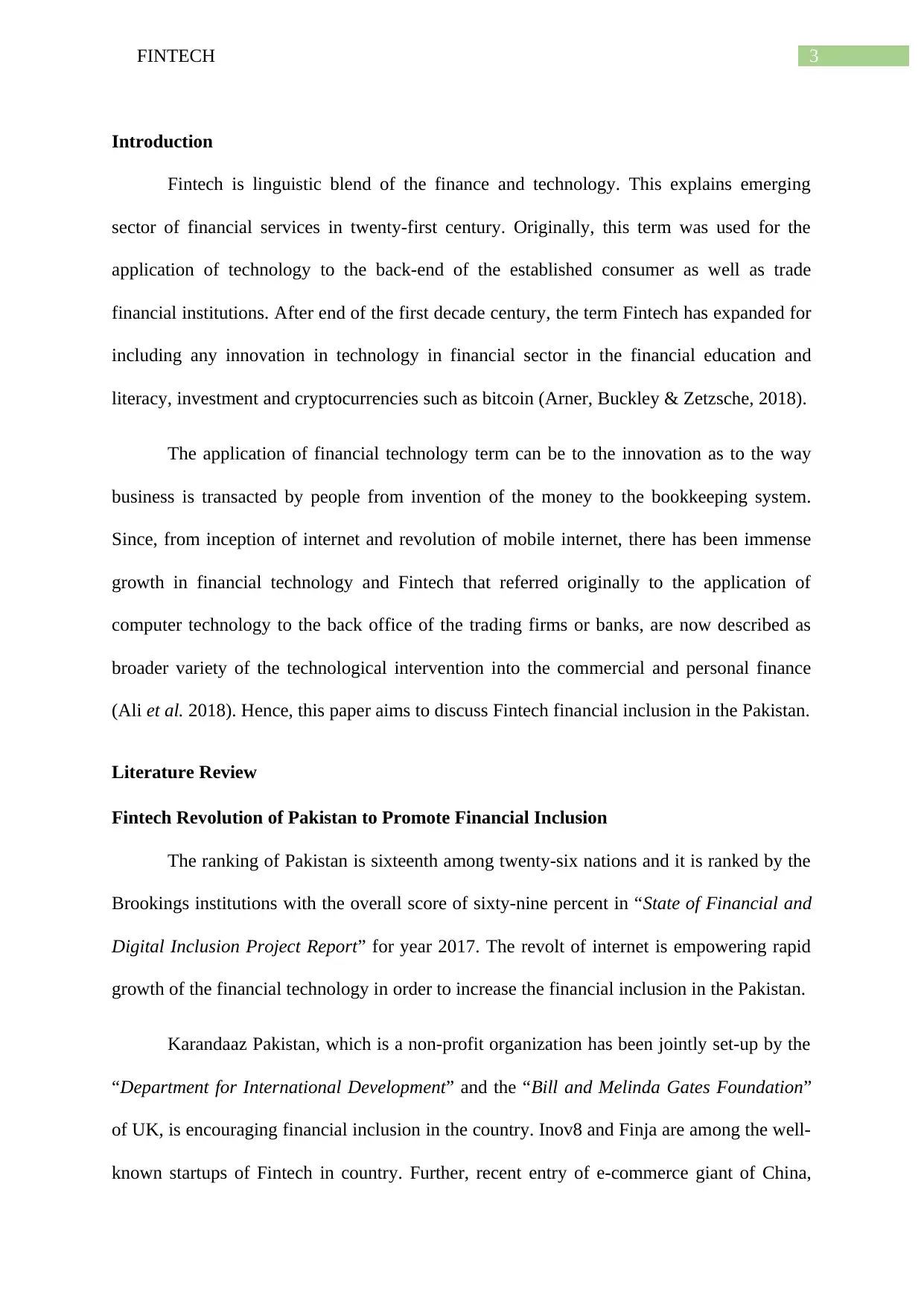
3FINTECH
Introduction
Fintech is linguistic blend of the finance and technology. This explains emerging
sector of financial services in twenty-first century. Originally, this term was used for the
application of technology to the back-end of the established consumer as well as trade
financial institutions. After end of the first decade century, the term Fintech has expanded for
including any innovation in technology in financial sector in the financial education and
literacy, investment and cryptocurrencies such as bitcoin (Arner, Buckley & Zetzsche, 2018).
The application of financial technology term can be to the innovation as to the way
business is transacted by people from invention of the money to the bookkeeping system.
Since, from inception of internet and revolution of mobile internet, there has been immense
growth in financial technology and Fintech that referred originally to the application of
computer technology to the back office of the trading firms or banks, are now described as
broader variety of the technological intervention into the commercial and personal finance
(Ali et al. 2018). Hence, this paper aims to discuss Fintech financial inclusion in the Pakistan.
Literature Review
Fintech Revolution of Pakistan to Promote Financial Inclusion
The ranking of Pakistan is sixteenth among twenty-six nations and it is ranked by the
Brookings institutions with the overall score of sixty-nine percent in “State of Financial and
Digital Inclusion Project Report” for year 2017. The revolt of internet is empowering rapid
growth of the financial technology in order to increase the financial inclusion in the Pakistan.
Karandaaz Pakistan, which is a non-profit organization has been jointly set-up by the
“Department for International Development” and the “Bill and Melinda Gates Foundation”
of UK, is encouraging financial inclusion in the country. Inov8 and Finja are among the well-
known startups of Fintech in country. Further, recent entry of e-commerce giant of China,
Introduction
Fintech is linguistic blend of the finance and technology. This explains emerging
sector of financial services in twenty-first century. Originally, this term was used for the
application of technology to the back-end of the established consumer as well as trade
financial institutions. After end of the first decade century, the term Fintech has expanded for
including any innovation in technology in financial sector in the financial education and
literacy, investment and cryptocurrencies such as bitcoin (Arner, Buckley & Zetzsche, 2018).
The application of financial technology term can be to the innovation as to the way
business is transacted by people from invention of the money to the bookkeeping system.
Since, from inception of internet and revolution of mobile internet, there has been immense
growth in financial technology and Fintech that referred originally to the application of
computer technology to the back office of the trading firms or banks, are now described as
broader variety of the technological intervention into the commercial and personal finance
(Ali et al. 2018). Hence, this paper aims to discuss Fintech financial inclusion in the Pakistan.
Literature Review
Fintech Revolution of Pakistan to Promote Financial Inclusion
The ranking of Pakistan is sixteenth among twenty-six nations and it is ranked by the
Brookings institutions with the overall score of sixty-nine percent in “State of Financial and
Digital Inclusion Project Report” for year 2017. The revolt of internet is empowering rapid
growth of the financial technology in order to increase the financial inclusion in the Pakistan.
Karandaaz Pakistan, which is a non-profit organization has been jointly set-up by the
“Department for International Development” and the “Bill and Melinda Gates Foundation”
of UK, is encouraging financial inclusion in the country. Inov8 and Finja are among the well-
known startups of Fintech in country. Further, recent entry of e-commerce giant of China,
Paraphrase This Document
Need a fresh take? Get an instant paraphrase of this document with our AI Paraphraser
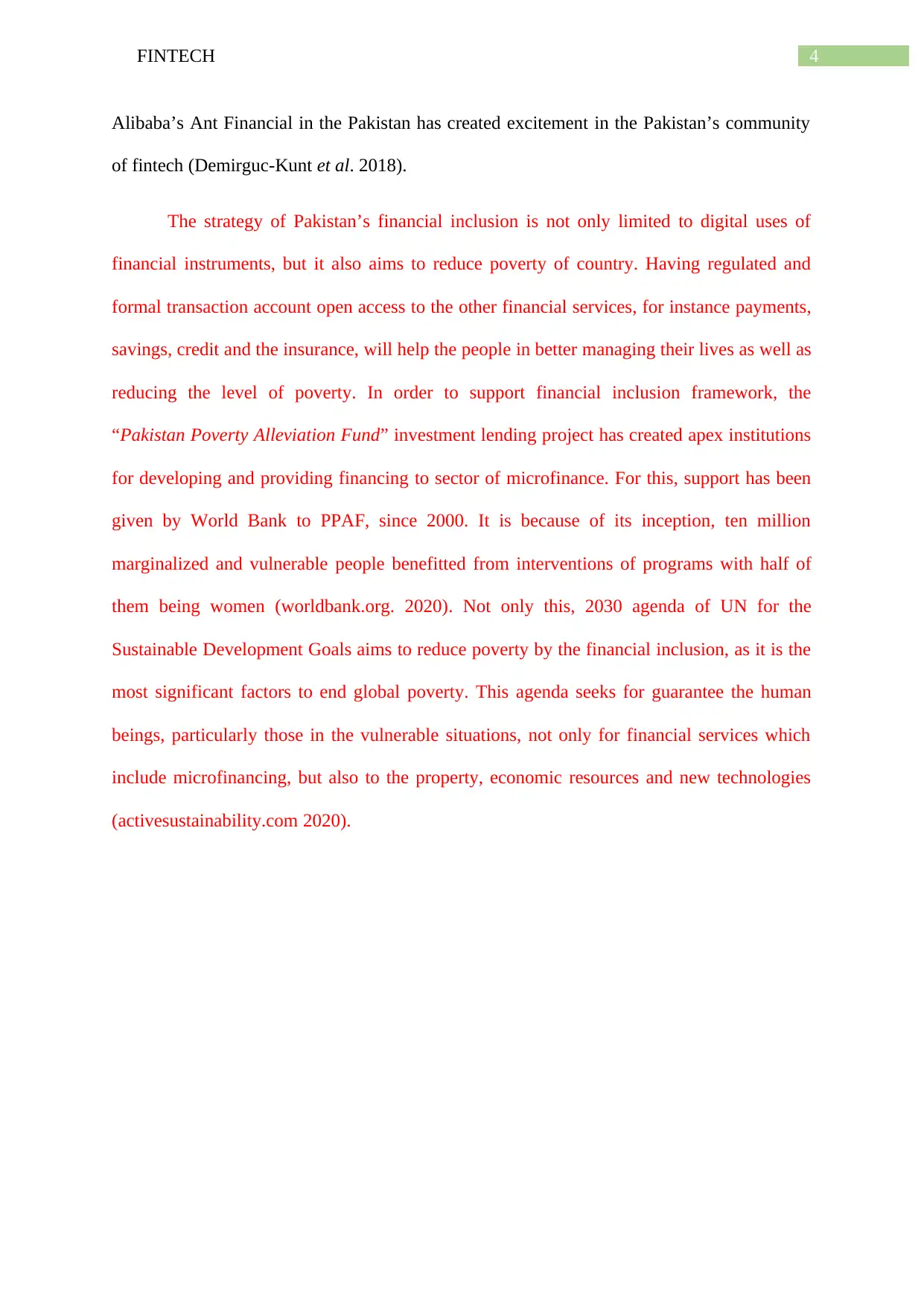
4FINTECH
Alibaba’s Ant Financial in the Pakistan has created excitement in the Pakistan’s community
of fintech (Demirguc-Kunt et al. 2018).
The strategy of Pakistan’s financial inclusion is not only limited to digital uses of
financial instruments, but it also aims to reduce poverty of country. Having regulated and
formal transaction account open access to the other financial services, for instance payments,
savings, credit and the insurance, will help the people in better managing their lives as well as
reducing the level of poverty. In order to support financial inclusion framework, the
“Pakistan Poverty Alleviation Fund” investment lending project has created apex institutions
for developing and providing financing to sector of microfinance. For this, support has been
given by World Bank to PPAF, since 2000. It is because of its inception, ten million
marginalized and vulnerable people benefitted from interventions of programs with half of
them being women (worldbank.org. 2020). Not only this, 2030 agenda of UN for the
Sustainable Development Goals aims to reduce poverty by the financial inclusion, as it is the
most significant factors to end global poverty. This agenda seeks for guarantee the human
beings, particularly those in the vulnerable situations, not only for financial services which
include microfinancing, but also to the property, economic resources and new technologies
(activesustainability.com 2020).
Alibaba’s Ant Financial in the Pakistan has created excitement in the Pakistan’s community
of fintech (Demirguc-Kunt et al. 2018).
The strategy of Pakistan’s financial inclusion is not only limited to digital uses of
financial instruments, but it also aims to reduce poverty of country. Having regulated and
formal transaction account open access to the other financial services, for instance payments,
savings, credit and the insurance, will help the people in better managing their lives as well as
reducing the level of poverty. In order to support financial inclusion framework, the
“Pakistan Poverty Alleviation Fund” investment lending project has created apex institutions
for developing and providing financing to sector of microfinance. For this, support has been
given by World Bank to PPAF, since 2000. It is because of its inception, ten million
marginalized and vulnerable people benefitted from interventions of programs with half of
them being women (worldbank.org. 2020). Not only this, 2030 agenda of UN for the
Sustainable Development Goals aims to reduce poverty by the financial inclusion, as it is the
most significant factors to end global poverty. This agenda seeks for guarantee the human
beings, particularly those in the vulnerable situations, not only for financial services which
include microfinancing, but also to the property, economic resources and new technologies
(activesustainability.com 2020).
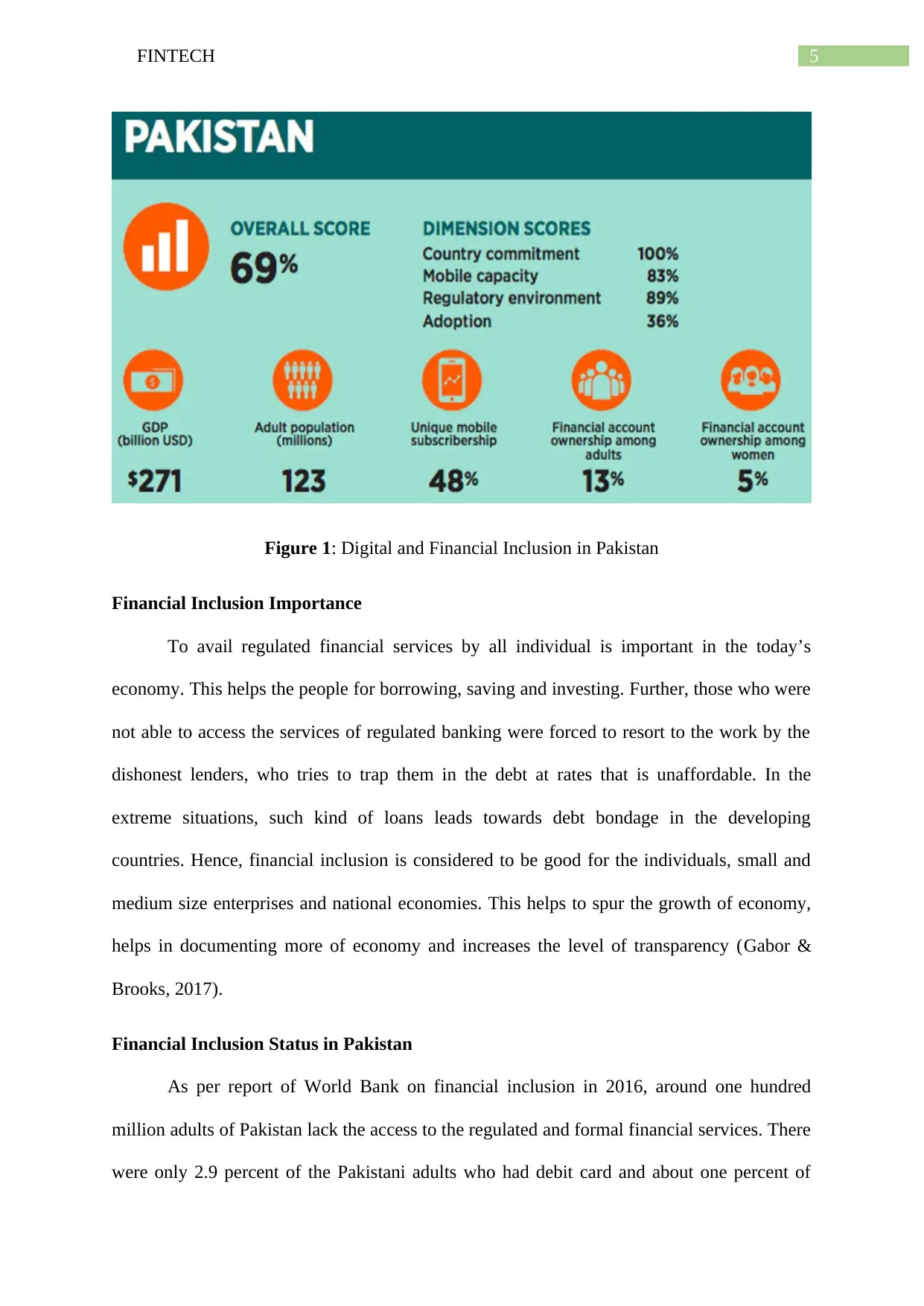
5FINTECH
Figure 1: Digital and Financial Inclusion in Pakistan
Financial Inclusion Importance
To avail regulated financial services by all individual is important in the today’s
economy. This helps the people for borrowing, saving and investing. Further, those who were
not able to access the services of regulated banking were forced to resort to the work by the
dishonest lenders, who tries to trap them in the debt at rates that is unaffordable. In the
extreme situations, such kind of loans leads towards debt bondage in the developing
countries. Hence, financial inclusion is considered to be good for the individuals, small and
medium size enterprises and national economies. This helps to spur the growth of economy,
helps in documenting more of economy and increases the level of transparency (Gabor &
Brooks, 2017).
Financial Inclusion Status in Pakistan
As per report of World Bank on financial inclusion in 2016, around one hundred
million adults of Pakistan lack the access to the regulated and formal financial services. There
were only 2.9 percent of the Pakistani adults who had debit card and about one percent of
Figure 1: Digital and Financial Inclusion in Pakistan
Financial Inclusion Importance
To avail regulated financial services by all individual is important in the today’s
economy. This helps the people for borrowing, saving and investing. Further, those who were
not able to access the services of regulated banking were forced to resort to the work by the
dishonest lenders, who tries to trap them in the debt at rates that is unaffordable. In the
extreme situations, such kind of loans leads towards debt bondage in the developing
countries. Hence, financial inclusion is considered to be good for the individuals, small and
medium size enterprises and national economies. This helps to spur the growth of economy,
helps in documenting more of economy and increases the level of transparency (Gabor &
Brooks, 2017).
Financial Inclusion Status in Pakistan
As per report of World Bank on financial inclusion in 2016, around one hundred
million adults of Pakistan lack the access to the regulated and formal financial services. There
were only 2.9 percent of the Pakistani adults who had debit card and about one percent of
⊘ This is a preview!⊘
Do you want full access?
Subscribe today to unlock all pages.

Trusted by 1+ million students worldwide
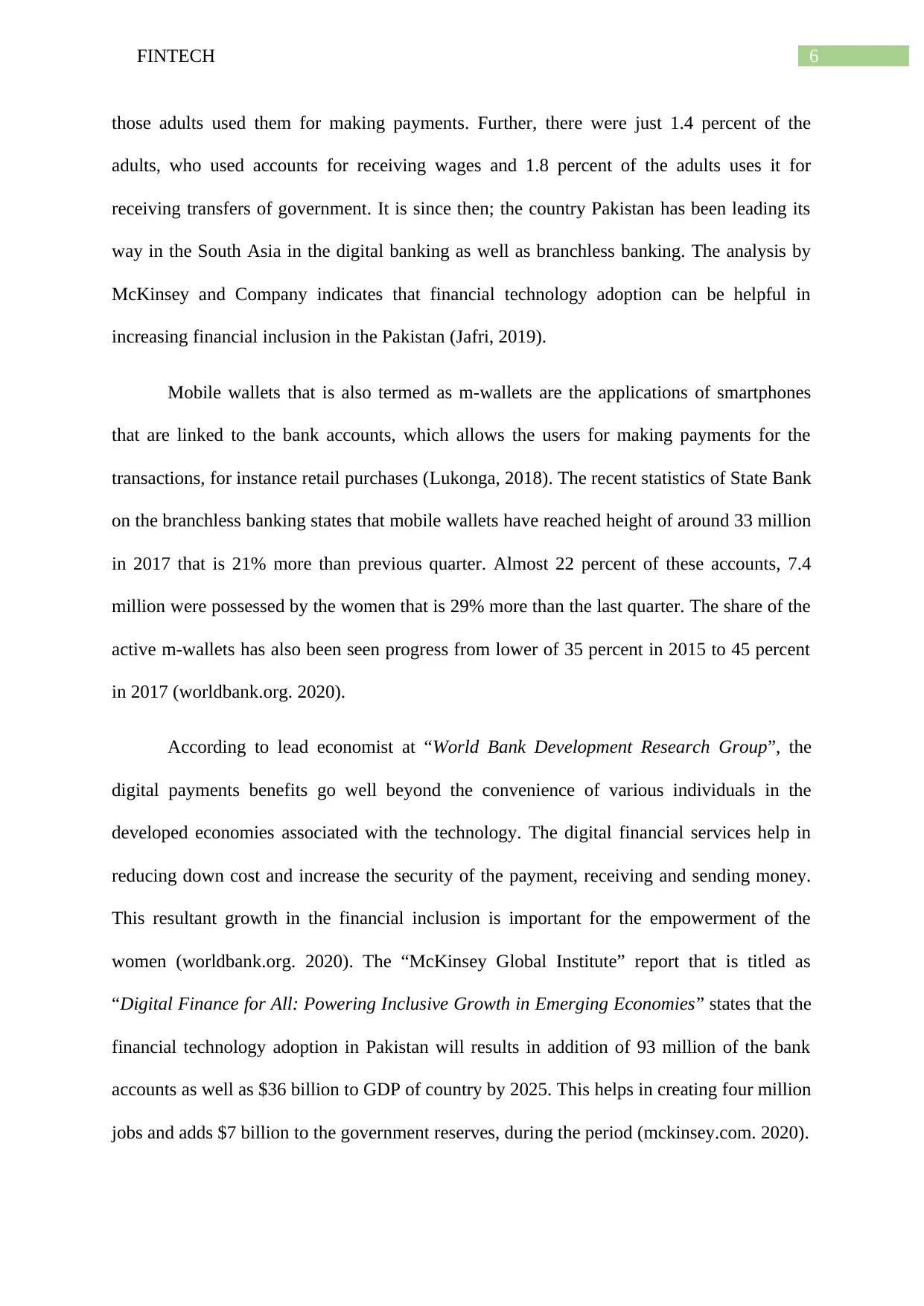
6FINTECH
those adults used them for making payments. Further, there were just 1.4 percent of the
adults, who used accounts for receiving wages and 1.8 percent of the adults uses it for
receiving transfers of government. It is since then; the country Pakistan has been leading its
way in the South Asia in the digital banking as well as branchless banking. The analysis by
McKinsey and Company indicates that financial technology adoption can be helpful in
increasing financial inclusion in the Pakistan (Jafri, 2019).
Mobile wallets that is also termed as m-wallets are the applications of smartphones
that are linked to the bank accounts, which allows the users for making payments for the
transactions, for instance retail purchases (Lukonga, 2018). The recent statistics of State Bank
on the branchless banking states that mobile wallets have reached height of around 33 million
in 2017 that is 21% more than previous quarter. Almost 22 percent of these accounts, 7.4
million were possessed by the women that is 29% more than the last quarter. The share of the
active m-wallets has also been seen progress from lower of 35 percent in 2015 to 45 percent
in 2017 (worldbank.org. 2020).
According to lead economist at “World Bank Development Research Group”, the
digital payments benefits go well beyond the convenience of various individuals in the
developed economies associated with the technology. The digital financial services help in
reducing down cost and increase the security of the payment, receiving and sending money.
This resultant growth in the financial inclusion is important for the empowerment of the
women (worldbank.org. 2020). The “McKinsey Global Institute” report that is titled as
“Digital Finance for All: Powering Inclusive Growth in Emerging Economies” states that the
financial technology adoption in Pakistan will results in addition of 93 million of the bank
accounts as well as $36 billion to GDP of country by 2025. This helps in creating four million
jobs and adds $7 billion to the government reserves, during the period (mckinsey.com. 2020).
those adults used them for making payments. Further, there were just 1.4 percent of the
adults, who used accounts for receiving wages and 1.8 percent of the adults uses it for
receiving transfers of government. It is since then; the country Pakistan has been leading its
way in the South Asia in the digital banking as well as branchless banking. The analysis by
McKinsey and Company indicates that financial technology adoption can be helpful in
increasing financial inclusion in the Pakistan (Jafri, 2019).
Mobile wallets that is also termed as m-wallets are the applications of smartphones
that are linked to the bank accounts, which allows the users for making payments for the
transactions, for instance retail purchases (Lukonga, 2018). The recent statistics of State Bank
on the branchless banking states that mobile wallets have reached height of around 33 million
in 2017 that is 21% more than previous quarter. Almost 22 percent of these accounts, 7.4
million were possessed by the women that is 29% more than the last quarter. The share of the
active m-wallets has also been seen progress from lower of 35 percent in 2015 to 45 percent
in 2017 (worldbank.org. 2020).
According to lead economist at “World Bank Development Research Group”, the
digital payments benefits go well beyond the convenience of various individuals in the
developed economies associated with the technology. The digital financial services help in
reducing down cost and increase the security of the payment, receiving and sending money.
This resultant growth in the financial inclusion is important for the empowerment of the
women (worldbank.org. 2020). The “McKinsey Global Institute” report that is titled as
“Digital Finance for All: Powering Inclusive Growth in Emerging Economies” states that the
financial technology adoption in Pakistan will results in addition of 93 million of the bank
accounts as well as $36 billion to GDP of country by 2025. This helps in creating four million
jobs and adds $7 billion to the government reserves, during the period (mckinsey.com. 2020).
Paraphrase This Document
Need a fresh take? Get an instant paraphrase of this document with our AI Paraphraser
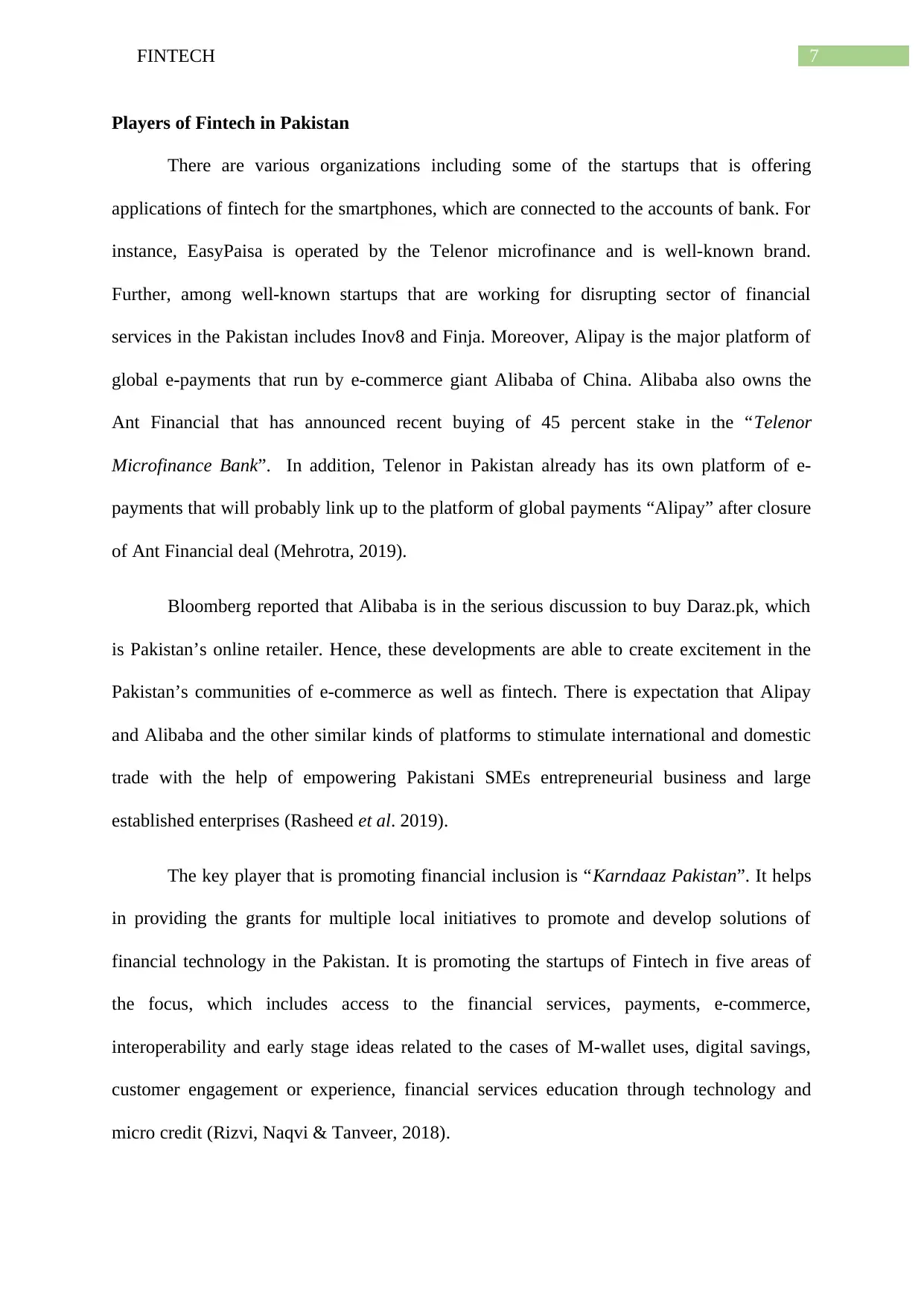
7FINTECH
Players of Fintech in Pakistan
There are various organizations including some of the startups that is offering
applications of fintech for the smartphones, which are connected to the accounts of bank. For
instance, EasyPaisa is operated by the Telenor microfinance and is well-known brand.
Further, among well-known startups that are working for disrupting sector of financial
services in the Pakistan includes Inov8 and Finja. Moreover, Alipay is the major platform of
global e-payments that run by e-commerce giant Alibaba of China. Alibaba also owns the
Ant Financial that has announced recent buying of 45 percent stake in the “Telenor
Microfinance Bank”. In addition, Telenor in Pakistan already has its own platform of e-
payments that will probably link up to the platform of global payments “Alipay” after closure
of Ant Financial deal (Mehrotra, 2019).
Bloomberg reported that Alibaba is in the serious discussion to buy Daraz.pk, which
is Pakistan’s online retailer. Hence, these developments are able to create excitement in the
Pakistan’s communities of e-commerce as well as fintech. There is expectation that Alipay
and Alibaba and the other similar kinds of platforms to stimulate international and domestic
trade with the help of empowering Pakistani SMEs entrepreneurial business and large
established enterprises (Rasheed et al. 2019).
The key player that is promoting financial inclusion is “Karndaaz Pakistan”. It helps
in providing the grants for multiple local initiatives to promote and develop solutions of
financial technology in the Pakistan. It is promoting the startups of Fintech in five areas of
the focus, which includes access to the financial services, payments, e-commerce,
interoperability and early stage ideas related to the cases of M-wallet uses, digital savings,
customer engagement or experience, financial services education through technology and
micro credit (Rizvi, Naqvi & Tanveer, 2018).
Players of Fintech in Pakistan
There are various organizations including some of the startups that is offering
applications of fintech for the smartphones, which are connected to the accounts of bank. For
instance, EasyPaisa is operated by the Telenor microfinance and is well-known brand.
Further, among well-known startups that are working for disrupting sector of financial
services in the Pakistan includes Inov8 and Finja. Moreover, Alipay is the major platform of
global e-payments that run by e-commerce giant Alibaba of China. Alibaba also owns the
Ant Financial that has announced recent buying of 45 percent stake in the “Telenor
Microfinance Bank”. In addition, Telenor in Pakistan already has its own platform of e-
payments that will probably link up to the platform of global payments “Alipay” after closure
of Ant Financial deal (Mehrotra, 2019).
Bloomberg reported that Alibaba is in the serious discussion to buy Daraz.pk, which
is Pakistan’s online retailer. Hence, these developments are able to create excitement in the
Pakistan’s communities of e-commerce as well as fintech. There is expectation that Alipay
and Alibaba and the other similar kinds of platforms to stimulate international and domestic
trade with the help of empowering Pakistani SMEs entrepreneurial business and large
established enterprises (Rasheed et al. 2019).
The key player that is promoting financial inclusion is “Karndaaz Pakistan”. It helps
in providing the grants for multiple local initiatives to promote and develop solutions of
financial technology in the Pakistan. It is promoting the startups of Fintech in five areas of
the focus, which includes access to the financial services, payments, e-commerce,
interoperability and early stage ideas related to the cases of M-wallet uses, digital savings,
customer engagement or experience, financial services education through technology and
micro credit (Rizvi, Naqvi & Tanveer, 2018).
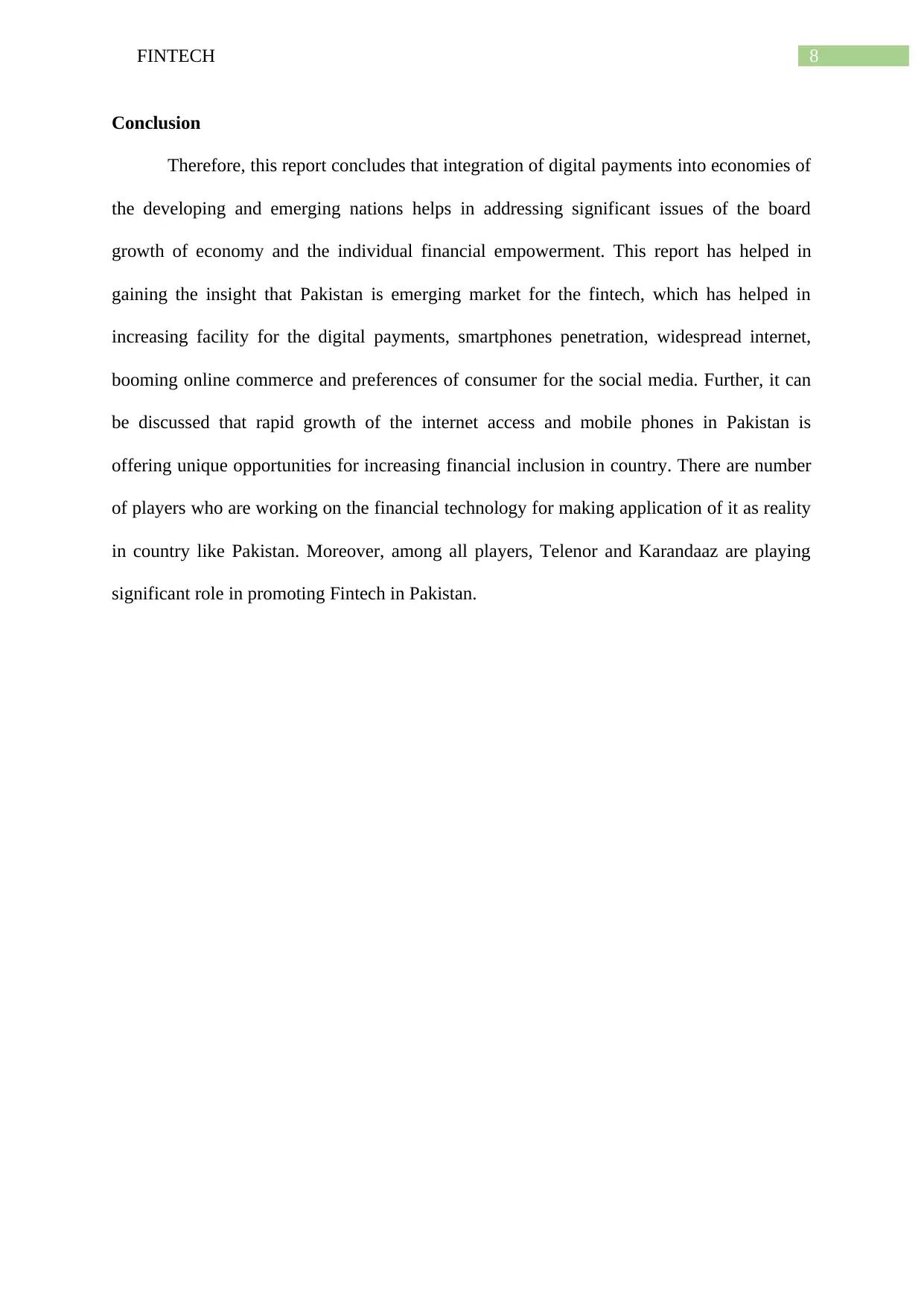
8FINTECH
Conclusion
Therefore, this report concludes that integration of digital payments into economies of
the developing and emerging nations helps in addressing significant issues of the board
growth of economy and the individual financial empowerment. This report has helped in
gaining the insight that Pakistan is emerging market for the fintech, which has helped in
increasing facility for the digital payments, smartphones penetration, widespread internet,
booming online commerce and preferences of consumer for the social media. Further, it can
be discussed that rapid growth of the internet access and mobile phones in Pakistan is
offering unique opportunities for increasing financial inclusion in country. There are number
of players who are working on the financial technology for making application of it as reality
in country like Pakistan. Moreover, among all players, Telenor and Karandaaz are playing
significant role in promoting Fintech in Pakistan.
Conclusion
Therefore, this report concludes that integration of digital payments into economies of
the developing and emerging nations helps in addressing significant issues of the board
growth of economy and the individual financial empowerment. This report has helped in
gaining the insight that Pakistan is emerging market for the fintech, which has helped in
increasing facility for the digital payments, smartphones penetration, widespread internet,
booming online commerce and preferences of consumer for the social media. Further, it can
be discussed that rapid growth of the internet access and mobile phones in Pakistan is
offering unique opportunities for increasing financial inclusion in country. There are number
of players who are working on the financial technology for making application of it as reality
in country like Pakistan. Moreover, among all players, Telenor and Karandaaz are playing
significant role in promoting Fintech in Pakistan.
⊘ This is a preview!⊘
Do you want full access?
Subscribe today to unlock all pages.

Trusted by 1+ million students worldwide
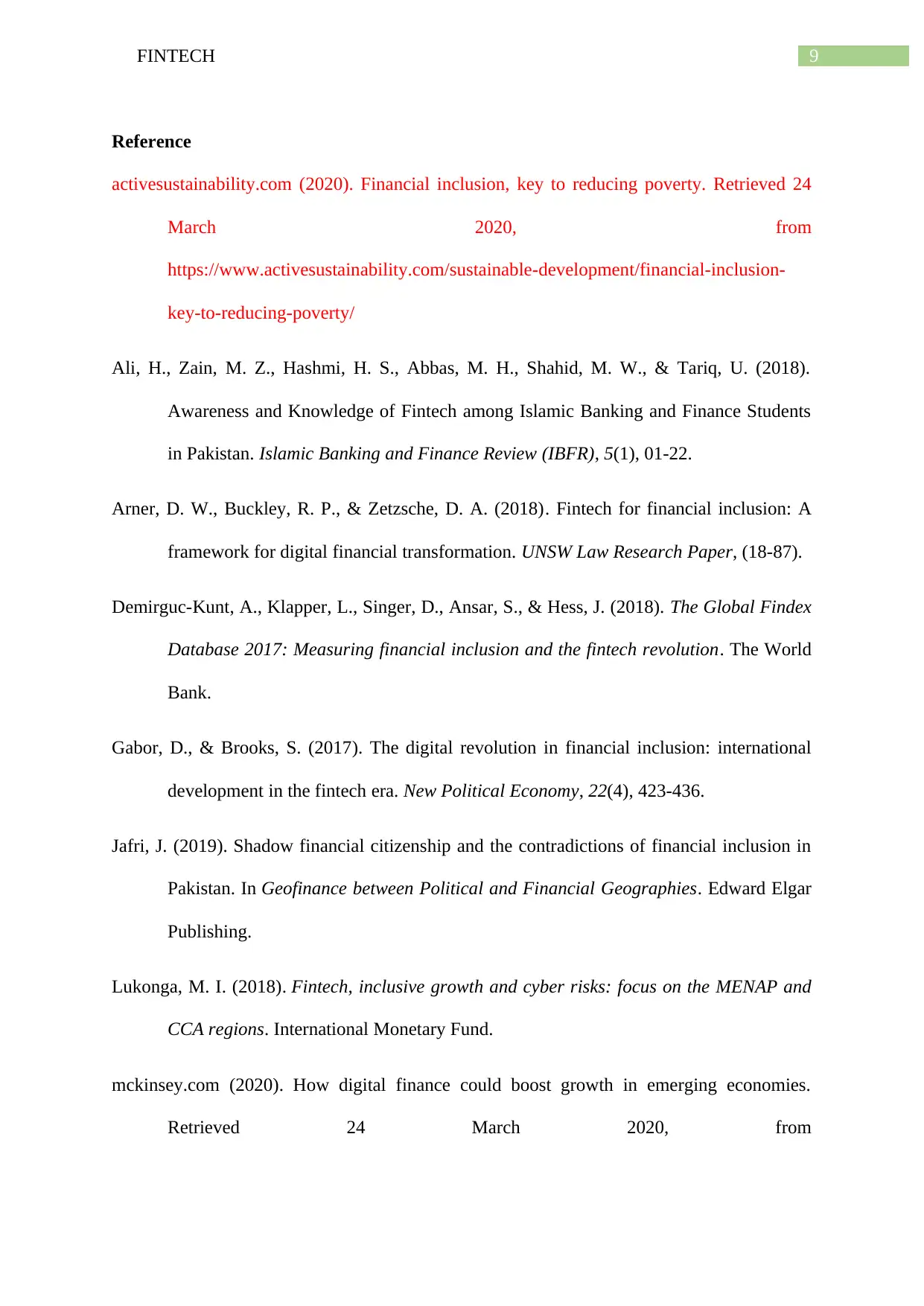
9FINTECH
Reference
activesustainability.com (2020). Financial inclusion, key to reducing poverty. Retrieved 24
March 2020, from
https://www.activesustainability.com/sustainable-development/financial-inclusion-
key-to-reducing-poverty/
Ali, H., Zain, M. Z., Hashmi, H. S., Abbas, M. H., Shahid, M. W., & Tariq, U. (2018).
Awareness and Knowledge of Fintech among Islamic Banking and Finance Students
in Pakistan. Islamic Banking and Finance Review (IBFR), 5(1), 01-22.
Arner, D. W., Buckley, R. P., & Zetzsche, D. A. (2018). Fintech for financial inclusion: A
framework for digital financial transformation. UNSW Law Research Paper, (18-87).
Demirguc-Kunt, A., Klapper, L., Singer, D., Ansar, S., & Hess, J. (2018). The Global Findex
Database 2017: Measuring financial inclusion and the fintech revolution. The World
Bank.
Gabor, D., & Brooks, S. (2017). The digital revolution in financial inclusion: international
development in the fintech era. New Political Economy, 22(4), 423-436.
Jafri, J. (2019). Shadow financial citizenship and the contradictions of financial inclusion in
Pakistan. In Geofinance between Political and Financial Geographies. Edward Elgar
Publishing.
Lukonga, M. I. (2018). Fintech, inclusive growth and cyber risks: focus on the MENAP and
CCA regions. International Monetary Fund.
mckinsey.com (2020). How digital finance could boost growth in emerging economies.
Retrieved 24 March 2020, from
Reference
activesustainability.com (2020). Financial inclusion, key to reducing poverty. Retrieved 24
March 2020, from
https://www.activesustainability.com/sustainable-development/financial-inclusion-
key-to-reducing-poverty/
Ali, H., Zain, M. Z., Hashmi, H. S., Abbas, M. H., Shahid, M. W., & Tariq, U. (2018).
Awareness and Knowledge of Fintech among Islamic Banking and Finance Students
in Pakistan. Islamic Banking and Finance Review (IBFR), 5(1), 01-22.
Arner, D. W., Buckley, R. P., & Zetzsche, D. A. (2018). Fintech for financial inclusion: A
framework for digital financial transformation. UNSW Law Research Paper, (18-87).
Demirguc-Kunt, A., Klapper, L., Singer, D., Ansar, S., & Hess, J. (2018). The Global Findex
Database 2017: Measuring financial inclusion and the fintech revolution. The World
Bank.
Gabor, D., & Brooks, S. (2017). The digital revolution in financial inclusion: international
development in the fintech era. New Political Economy, 22(4), 423-436.
Jafri, J. (2019). Shadow financial citizenship and the contradictions of financial inclusion in
Pakistan. In Geofinance between Political and Financial Geographies. Edward Elgar
Publishing.
Lukonga, M. I. (2018). Fintech, inclusive growth and cyber risks: focus on the MENAP and
CCA regions. International Monetary Fund.
mckinsey.com (2020). How digital finance could boost growth in emerging economies.
Retrieved 24 March 2020, from
Paraphrase This Document
Need a fresh take? Get an instant paraphrase of this document with our AI Paraphraser
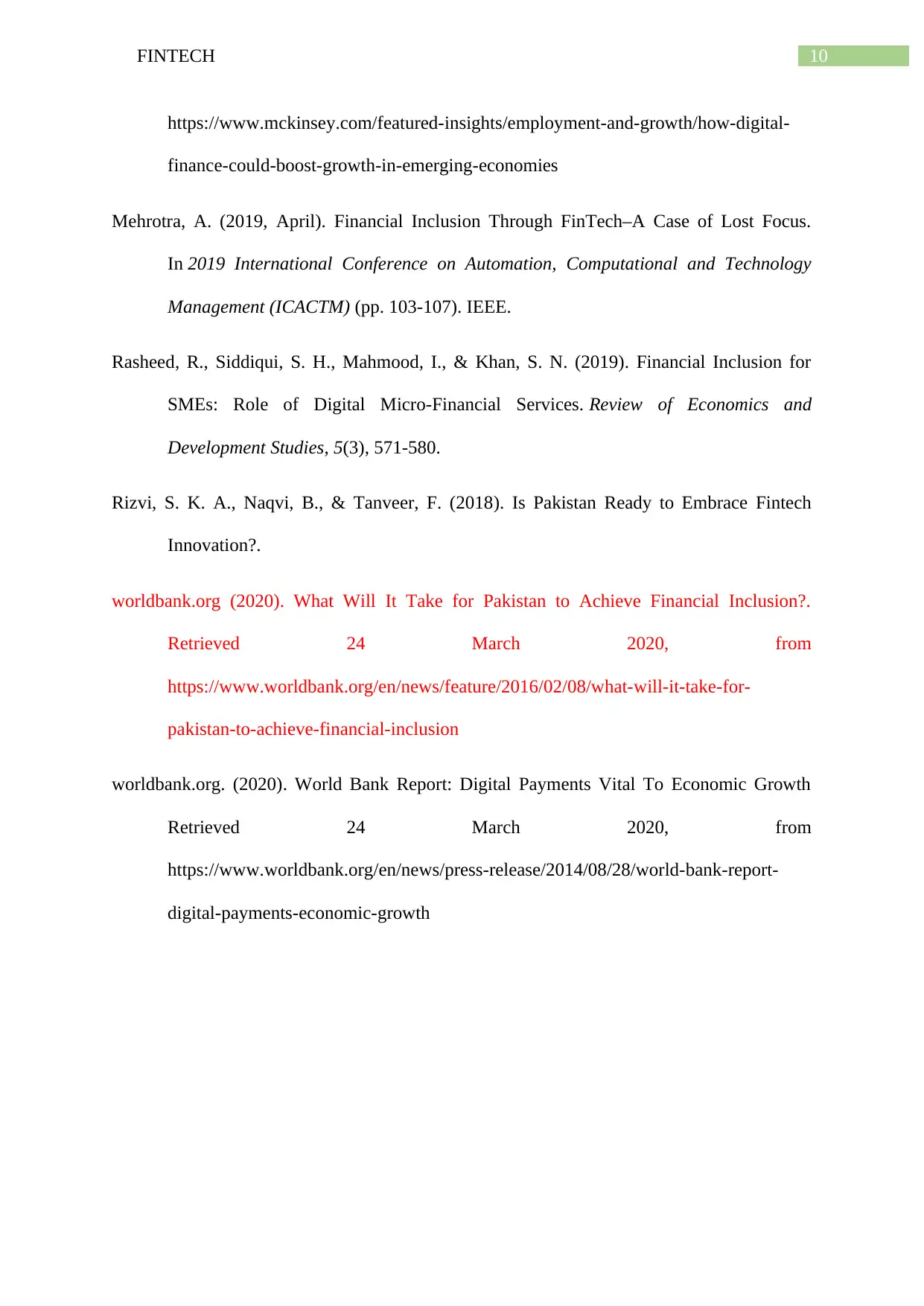
10FINTECH
https://www.mckinsey.com/featured-insights/employment-and-growth/how-digital-
finance-could-boost-growth-in-emerging-economies
Mehrotra, A. (2019, April). Financial Inclusion Through FinTech–A Case of Lost Focus.
In 2019 International Conference on Automation, Computational and Technology
Management (ICACTM) (pp. 103-107). IEEE.
Rasheed, R., Siddiqui, S. H., Mahmood, I., & Khan, S. N. (2019). Financial Inclusion for
SMEs: Role of Digital Micro-Financial Services. Review of Economics and
Development Studies, 5(3), 571-580.
Rizvi, S. K. A., Naqvi, B., & Tanveer, F. (2018). Is Pakistan Ready to Embrace Fintech
Innovation?.
worldbank.org (2020). What Will It Take for Pakistan to Achieve Financial Inclusion?.
Retrieved 24 March 2020, from
https://www.worldbank.org/en/news/feature/2016/02/08/what-will-it-take-for-
pakistan-to-achieve-financial-inclusion
worldbank.org. (2020). World Bank Report: Digital Payments Vital To Economic Growth
Retrieved 24 March 2020, from
https://www.worldbank.org/en/news/press-release/2014/08/28/world-bank-report-
digital-payments-economic-growth
https://www.mckinsey.com/featured-insights/employment-and-growth/how-digital-
finance-could-boost-growth-in-emerging-economies
Mehrotra, A. (2019, April). Financial Inclusion Through FinTech–A Case of Lost Focus.
In 2019 International Conference on Automation, Computational and Technology
Management (ICACTM) (pp. 103-107). IEEE.
Rasheed, R., Siddiqui, S. H., Mahmood, I., & Khan, S. N. (2019). Financial Inclusion for
SMEs: Role of Digital Micro-Financial Services. Review of Economics and
Development Studies, 5(3), 571-580.
Rizvi, S. K. A., Naqvi, B., & Tanveer, F. (2018). Is Pakistan Ready to Embrace Fintech
Innovation?.
worldbank.org (2020). What Will It Take for Pakistan to Achieve Financial Inclusion?.
Retrieved 24 March 2020, from
https://www.worldbank.org/en/news/feature/2016/02/08/what-will-it-take-for-
pakistan-to-achieve-financial-inclusion
worldbank.org. (2020). World Bank Report: Digital Payments Vital To Economic Growth
Retrieved 24 March 2020, from
https://www.worldbank.org/en/news/press-release/2014/08/28/world-bank-report-
digital-payments-economic-growth
1 out of 11
Related Documents
Your All-in-One AI-Powered Toolkit for Academic Success.
+13062052269
info@desklib.com
Available 24*7 on WhatsApp / Email
![[object Object]](/_next/static/media/star-bottom.7253800d.svg)
Unlock your academic potential
Copyright © 2020–2025 A2Z Services. All Rights Reserved. Developed and managed by ZUCOL.





